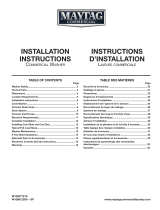
9
If moving, or not using your washer for a period of time, follow
these steps:
1. Unplug or disconnect power to washer.
2. Turn off water supply to washer to avoid ooding due
to water pressure surge.
WINTER STORAGE CARE
IMPORTANT: To avoid damage, install and store washer
where it will not freeze. Because some water may stay in
hoses, freezing can damage washer. If storing or moving
during freezing weather, winterize your washer.
To winterize washer:
1. Shut off both water faucets; disconnect and drain water
inlet hoses.
2. Put 1 qt. (1 L) of R.V.-type antifreeze in basket and run
a wash cycle for about 30 seconds to mix antifreeze and
remaining water.
3. Unplug washer or disconnect power.
NON-USE AND VACATION CARE
Replace inlet hoses after 5 years of use to reduce the risk
of hose failure. Periodically inspect and replace inlet hoses
if bulges, kinks, cuts, wear, or leaks are found.
When replacing your inlet hoses, mark the date of replacement
on the label with a permanent marker.
WATER INLET HOSES
WASHER MAINTENANCE
WASHER CARE
Recommendations to Help Keep Your Washer Clean and
Performing at Its Best
1. Always follow the detergent manufacturer’s instructions
regarding the amount of detergent to use. Never use
more than the recommended amount because that
may increase the rate at which detergent and soil
residue accumulate inside your washer which,
in turn, may result in undesirable odor.
2. Use warm and hot wash water settings sometimes (not
exclusively cold water washes), because they do a better
job of controlling the rate at which soils and detergent
accumulate.
3. Always leave the washer lid open between uses to help
dry out the washer and prevent the buildup of odor-causing
residue.
Cleaning Your Top-Loading Washer
Read these instructions completely before beginning the
routine cleaning processes recommended below. This Washer
Maintenance Procedure should be performed, at a minimum,
once per month or every 30 wash cycles, whichever occurs
sooner, to control the rate at which soils and detergent may
otherwise accumulate in your washer.
Cleaning the Inside of the Washer
To keep your washer odor free, follow the usage instructions
provided above and use this recommended cleaning
procedure:
Recommended Cycle for Cleaning the Washer
For optimal cleaning, use chlorine bleach:
a. Open the washer lid and remove any clothing or items.
b. Add 1 cup (236 mL) of liquid chlorine bleach to the wash
basket.
NOTE: Use of more liquid chlorine bleach than is
recommended above could cause washer damage
over time.
c. Close the washer lid.
d. Do not add any detergent or other chemical to the washer
when following this procedure.
e. Select the PowerWash
®
cycle.
f. Press the START/PAUSE button to start the cycle.
NOTE: Do not interrupt cycle.
Cleaning the Fabric Softener Dispenser
After a period of using your washer, you may nd some residue
buildup in the dispenser. To remove residue from the dispenser,
wipe with a damp cloth and towel dry. Use an all-purpose
surface cleaner, if needed.
Cleaning the Outside of the Washer
Use a soft, damp cloth or sponge to wipe away any spills.
Use only mild soaps or cleaners when cleaning external
washer surfaces.
IMPORTANT: To avoid damaging the washer’s nish, do not
use abrasive products.
NOTE: The Clean Washer cycle should be used one or two
times a year. Check the Tech Sheet for access to the Clean
Washer cycle in the Diagnostic Test mode.
TRANSPORTING YOUR WASHER
1. Shut off both water faucets. Disconnect and drain water
inlet hoses.
2. If washer will be moved during freezing weather, follow
“Winter Storage Care” directions before moving.
3. Disconnect drain hose from drain system and drain any
remaining water into a pan or bucket. Disconnect drain
hose from back of washer.
4. Unplug power cord.
5. Place inlet hoses and drain hose inside washer basket.
6. Drape power cord over edge and into washer basket.
7. Place packing tray from original shipping materials back
inside washer. If you do not have packing tray, place heavy
blankets or towels into basket opening. Close lid and place
tape over lid and down front of washer. Keep lid taped until
washer is placed in new location.
8. Reinstall bottom shipping cone if available.




















